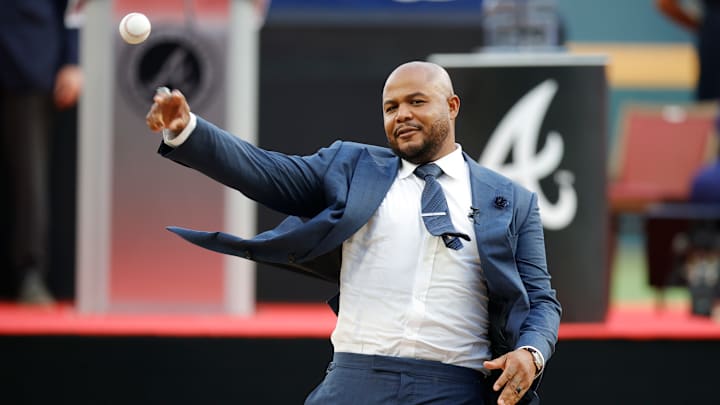More than any other person on this year’s Baseball Hall of Fame ballot, the candidacy of Andruw Jones is a Rorschach test of how voters gauge Hall eligibility.
Viewed one way, Jones’ candidacy is a slam dunk. Viewed by other standards, he clearly does not measure up. The Jones vote, then, tells us as much about Hall voters as it does about Jones.
Jones is in his seventh season of eligibility on the writers’ ballot. Last year, he was named on 58.1 percent of ballots, his best showing yet and up 17 percentage points from one year earlier. In the most recent update published by Ryan Thibodaux’s Hall of Fame Vote Tracker, he was at 66.1 percent of the 59 publicly known ballots. Candidates must receive 75 percent of votes cast in order to qualify for enshrinement.
Jones’ failure to reach that 75 percent figure mystifies many of his supporters, who see a clear and obvious enshrinee, maybe even a first-ballot-worthy one. They point to two numbers in particular as the cornerstones of the Jones candidacy.
The first is his home run total. Over a 17-season career, he hit 434 of them. Only three inductees whose primary position was center field have hit more, and those three are illustrious: Willie Mays, Mickey Mantle and Ken Griffey Jr.
The second number is Total Zone Runs, a SABRmetric number of fairly recent vintage that quantifies the number of runs the player saved based on number of plays made. Jones is first all time in this metric at 230 runs saved. That’s a healthy 54 runs ahead of the career runner-up, Willie Mays (176), and to believers in the stat, it suggests that Jones was a 30 percent more efficient fielder than Mays. Quite a statement indeed and plainly Hall-worthy … if true.
Total Zone Runs is a wonderful addition to the SABRmetric tool chest and a good way to measure contemporary fielding, historically a dark, nebulous world. But it has drawbacks, the principal one of which is its relative newness. That means the effort to reconstruct data fields retroactively is both time and labor intensive, if it is done at all.
And that fact undermines skeptics’ ability to compare Jones’ defensive skills with peers, including some of relatively recent vintage. Consider that for many Hall of Fame center fielders – Mickey Mantle, Kirby Puckett, Duke Snider and Larry Doby among them -- Total Zone Runs data simply does not exist.
For others, the data appears to be partial at best. Baseball-Reference gives Griffey Jr. a Total Zone Runs score of 6, a far cry indeed from Jones’ 230. Given that to a large extent their careers overlapped, there are only two ways to rationalize Griffey’s score of 6 against Jones’ score of 230. The first is to assume that Griffey was an incompetent center fielder, which nobody who saw him play believes. The second is to assume that Griffey’s retrofitted score is incomplete.
And that’s the fundamental problem some voters have in leaning on Total Zone Runs as an endorsement of Jones’ Hall-worthiness. There are, at this moment, 18 Cooperstown enshrinees whose primary position was center field. Even partial Total Zone Runs data exists for just three of them: Mays, Griffey and Richie Ashburn.
That doesn’t establish that Jones is unworthy; it just makes it more difficult to compare him to his potential brethren.
Voters can fall back on more traditional – and more generally available -- statistics, but aside from home runs, the case for Jones gets cloudier. For instance, Jones ranks sixth among the immortals in a slightly more established SABRmetric stat, Range Factor. But again, beyond a certain point, the data gets spotty. For only seven of the 18 center field inductees do we have full range factor data; in 10 cases, the data is only partial, and in the case of 19th century star Hugh Duffy, there is no range data at all.
Jones performs credibly in two of the more widely accepted synoptic numbers. He ranks ahead of half the current hall center fielders in WAR (62.7; the group average is 73.1). He also ranks eighth in Jay Jaffe’s JAWS system of evaluation (54.6 against a group average of 59.4).
For voters who prefer more traditional measurements, though, Jones’ candidacy doesn’t cut it. His career .254 batting average would, if he is elected, be the lowest for a Hall of Fame center fielder by 30 percentage points, Griffey’s .284 being the current low. The group average is .312.
His 111 OPS+ would rank ahead of only Lloyd Waner (99) and Max Carey (108), two widely panned inductees, and far below the 135 positional average for immortals.
His career 12.5 Win Probability Added would rank 16th, ahead of only Lloyd Waner. (There are no comparable numbers for 19th century stars Duffy and Billy Hamilton.)
His numbers in traditional fielding stats are in line with Hall occupants. He ranks seventh in total putouts, 14th in assists and ninth in fewest errors.
In short, if you vote based on home run totals and Total Zone Runs, Jones is an obvious choice. If you judge based on career WAR or if you are a Jaffe disciple, he’s probably worthy.
But if you judge him based on batting average, OPS+, or Win Probability Added, his candidacy falls flat.
In short, Jones’ Hall candidacy rides not on him but on what voters think is important. That’s what makes his case fascinating to watch.
Free agent SP Mike Clevinger remains on the market , but should teams pursue him? (calltothepen.com)
